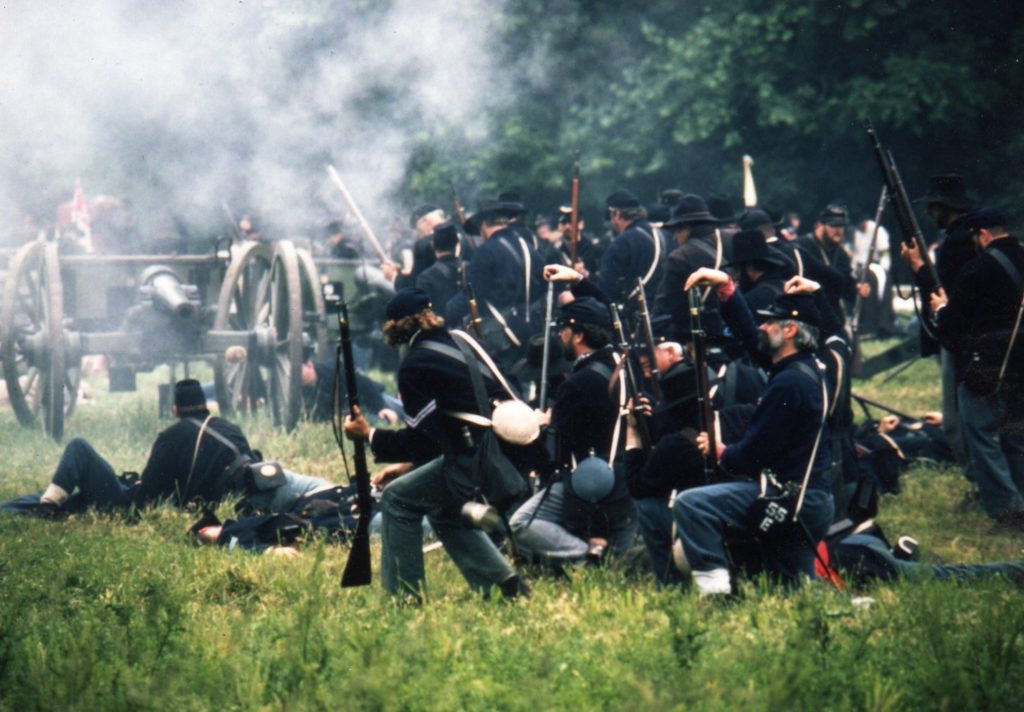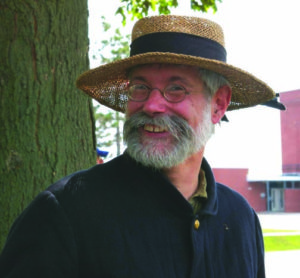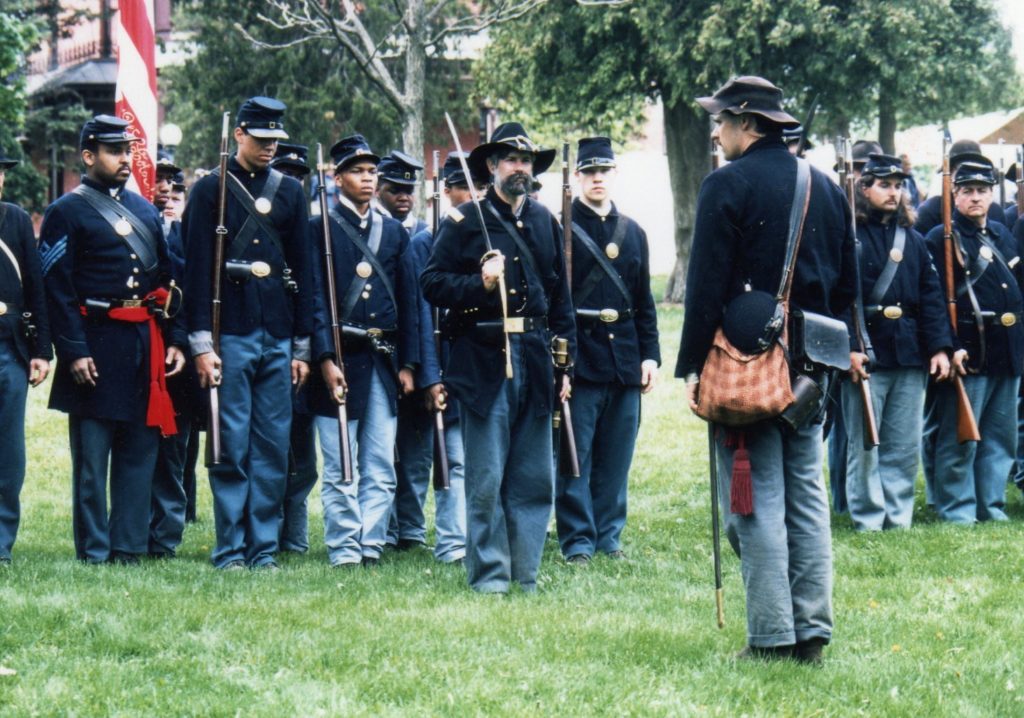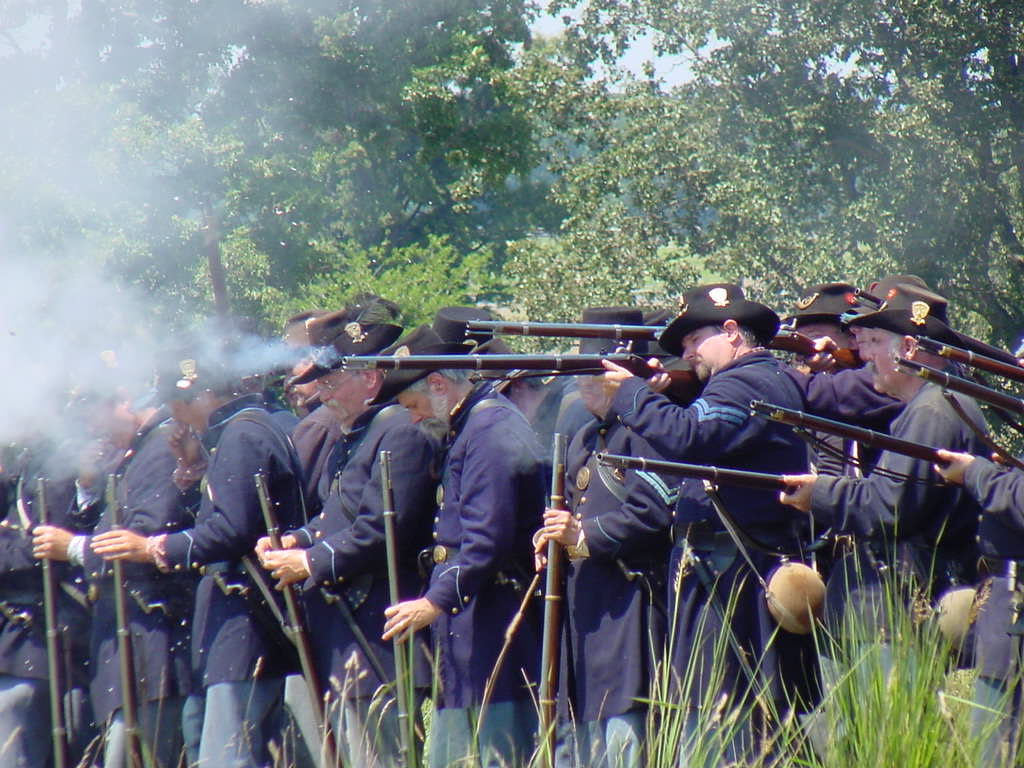BGES Treasurer Laurence Schiller retired in 2016 from his “real-life” profession at Northwestern University as history professor and the second winningest fencing coach in NCAA history. Interestingly, those jobs fit nicely into the broader scope of what Laurie loves to do—and continues to do: Reenact. He’s been a full-blown Civil War reenactor since 1994, typically representing the North. We caught up with Laurie, who still lives in Chicagoland with his wife, to learn about his hobby.

BGES Blog: How did you get started? How long have you been doing it?
LS: I started when I was 44 years old. I’m almost 70 now and I still do it. I was always interested in the American Civil War. I remember when I was 10, it was the Centennial in 1960. They published 50 or so baseball cards, but Civil War stuff. You would go to the supermarket, pay your nickel, and get these cards and bubble gum. I have a complete set, starting with John Brown. So I was always interested in the Civil War. But when I went to college, we were a family of protestors in the middle of the Vietnam War. It would have killed my dad if I went into military history. So I went into African history—my father’s field. Years later, after I was appointed fencing coach for the North Shore Region of the Prairie State Games, I ran into a guy, the women’s track coach at Glenbrook South HS, who also reenacted. I thought it was really cool. I knew it existed, but it was 1984. I couldn’t afford the cost of a musket, and I didn’t really know how to get into it.
Then some years later, I won my 500th career win in fencing. So my team bought me a reproduction staff and field sabre that would have been carried by a field officer in an infantry unit. And my wife, on our 20th anniversary, bought me a copy of Joshua Lawrence Chamberlain’s uniform from the company that made uniforms for the movie Gettysburg. Now I had the stuff … I called up my track coach friend and asked how to get involved. They had just started the 55th Illinois, attached to the 104th Illinois, so I did both. I did an assistant surgeon with the 55th until I got more equipment and did an infantryman with the 104th.

BGES Blog: How often do you reenact?
LS: Not as often as I would like! In the last 10 or 15 years the hobby has slid downhill in numbers. Sometimes we don’t even have 100 reenactors any more. The young people are not getting involved. Once the 150th anniversaries passed, there has been less interest. So now I may do it three or four times a year.
BGES Blog: What does a reenactment look like? What do you get out of it?
LS: Sometimes it’s a living history, not a reenactment. Those can be just one side, where you just talk to people. I like to stay in the first person, and chat with people about why we are there and what we do.
Sometimes we do local reenactments. And in those cases, we may be doing the Battle of X, but there’s really no resemblance to that battle. For example, we go to Naperville and say this is the Battle of Fort Donaldson. But it’s not really; it’s a generic representation, with the Feds winning one day and the Confederates winning the other day.
And then we have the national reenactments that are specific to the battle.
For me, part of it is talking to people, camping out with buddies, and having a good time. I disconnect myself from the 21st century as much as I can. That’s my personal motivation. Also, I’m a historian. For me, doing the movements that the military made always informed my teaching. I’ve taught classes about the Civil War, and to be able to share the experience—without people shooting at you—is useful. When I read some guy’s letter, stating we marched by the left flank, then moved forward, I know what he’s talking about. I have fought in rain storms, so I’ve seen how a musket can get so slippery you can hardly load it.

BGES Blog: Do you reenact specific soldiers?
LS: I have done George Hammett, a young man from Ohio. I didn’t know a lot more about him, and then discovered his grave last year in Fulton, Illinois. He was married and had a child on the way.
Also I’ve done William Bradshaw, a member of company F of the 2nd Wisconsin who was an Irishman born in Burlington, Vermont, in 1834. But his family had come from Northern Ireland just two years before, so I give him a brogue.
BGES Blog: How accurate do you try to be?
LS: In Tony Horwitz’s book Confederates in the Attic, he talks about the “Farbs,” which probably comes from “far be it for me to say, but….” These people are not very accurate. Then you have Rob Hodge in Horwitz’s book, who sleeps in the mud and is totally immersive. My units have always been more hardcore. We’re not going to go nuts and be miserable, but we try not to carry things that are not appropriate. I cook as authentically as I can. For me, it’s hardtack and bacon, not pop tarts. Though sometimes a woman connected to our unit offers to make us dinner, and I’m fine with that. That’s how I like to do the hobby. It makes me happy.
BGES Blog: What is the importance of reenactments in the overall scheme of the Civil War?
LS: Well, that’s a complicated question! People who reenact are three types. There are the people who are interested in the history of it. Unfortunately, many of them are narrowly focused on military history, so they can tell you about this gun, that cannon, but they miss the overall social/political/economics of what’s going on in the 1860s.
There are the people interested in history who try to give proper view of the time period as best they know it. Some might be doing it to honor the memory of an ancestor, some of whom are good historians, and others who don’t seem to care.
And then the third part are the yahoos. They want to play with guns. I’m sorry, but the majority are southern. They have the lost cause thing going. “Our ancestors were honorable, it’s liberal propaganda, slavery had nothing to do with it.” Those folks give the wrong impression and a false narrative. In New Orleans, I was on a tour, and the guide was trying to say the war was over tariffs, that they were doing it because they wanted to make money. It’s complete fantasy. But he was telling that to people on the tour, rather than give the proper context of the actual causes of the Civil War. I challenged him, but didn’t want to get into too much of an argument. It’s really pathetic. We [the serious reenactors] fight that.
So you have those three types of people who reenact.
To me, I think the Civil War plays a seminal part in our history. Had the Union failed to win, we would be a third-ranked power. The South would be a third-world nation with their economic system. They would have kept slavery, like Brazil, and then experienced some form of apartheid. But they don’t have the minerals or wealth of South Africa. They would have been a colony of the North, and northern manufacturing would have controlled them.
The North would have been a smaller country. And who knows what would have happened with the West?
Because the North won the war, we started on a path toward modern industrial state, becoming the most powerful country in the world.
So when we have reenactments, we have fun with it. But it’s also important to remember these things. We need to understand the role of slavery and how it continues to play into our politics, the white supremacy movement. Many white Southerners don’t understand why black people want to remove the Civil War monuments. It’s up to us to educate. And we can do that with reenactments. It’s good for people to come in and be exposed to this.
There was an interesting incident in Lake County, Illinois. Every year for 25 years they’ve had reenactments, at a park, there. This year it got canceled because the chair asked what did it have to do with African Americans? He said it’s white supremacy, just honoring white people. He got hammered for it. I’m a New York Jew, as liberal as they come. But I own guns. And yes, we fly the Confederate flag, because it’s historically correct. But reenacting is important as a continuation of understanding history. And it does it in a way that reaches the public more than a class does, where kids tune in and out.

BGES Blog: Is there one particular battle/reenactment that sums it up, that was absolutely amazing, that you’ll remember forever?
LS: I have two: 135th Antietam and 135th Gettysburg.
At Antietam, Maryland, in September 1997, I was 2nd Wisconsin, Iron Brigade. This guy had grown a cornfield for us. We got up at 4:30 in the morning, in the pitch black. We marched to a field covered in low-lying fog. My wife, who was a spectator, said she saw us going into cornfields with bayonets fixed. The historical moment was amazing. You couldn’t see anything in front of you. We hit a fence, and there was the Texas brigade. That’s what really happened.
And then Gettysburg on its 135th anniversary. There were 30,000 reenactors, battalion after battalion just coming into field. No one sees those kinds of numbers any more. We did a full-scale Pickett’s Charge, with 13,000 Confederates. There we represented the 42nd New York on July 3. I watched those guys get closer and closer. I knew they didn’t have real stuff, but I was getting nervous.
Another amazing moment, we were portraying 24th Michigan, which had been added to the Iron Brigade in the winter of 1862–63. These guys went toe to toe with 26th North Carolina, a big regiment. 24th Michigan began with 399 men. On Cemetery Ridge that evening, there were 26—an amazing casualty rate. We had 299 men, and we all took first person and did what happened exactly to that person. I was a corporal in 24th Michigan and I was wounded. That gives you goosebumps.
BGES Blog: Any last words?
LS: I have really enjoyed reenacting. Both the activity and interacting with the public. It is important to bring history alive and hopefully impact folks we come into contact with. And, we want to bring them honest history, not propaganda. The Civil War period is one of the most misunderstood in American history, and yet it is so important to our current history. I encourage everyone to learn about it and the lessons it has for today.
